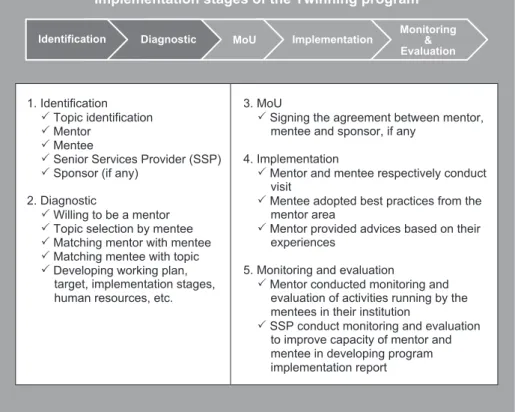36
Published by Research Institute for Humanity and Nature Proceedings of the Online International Symposium on the Sanitation Value Chain 2020 (SVC2020)
https://doi.org/10.34416/svc.00041
Sanitation Value Chain Vol. 5 (1) pp.036–037, 2021
* Correspondence
wsetiabudi@unicef.org
Twinning Programme: Learning from Horizontal Learning on Domestic Wastewater Treatment
in Three Districts in South Sulawesi
Wildan SETIABUDI
1*
1
UNICEF Makassar Field Office, UNICEF Indonesia, Indonesia
Keywords: faecal sludge management, safely managed sanitation, horizontal learning
Indonesia is committed to achieve Sustainable Development Goals, including target on safe and sustainable sanitation. More than 97% districts in Indonesia rely on the off-site sanitation system, which needs chain-service from the septic-tanks to the domestic waste-water treatment (DWWTP). In South Sulawesi, only seven out of 24 cities/districts already have DWWTP, which were built with big investment from the national budget. However, there are lack of management capacity to operate them by city/districts after the facilities were handed over.
Twinning programme is an information exchange programme through horizontal learning, initially developed by Indonesia’s Wastewater Operator Association (Forkalim) on off-site and on-site DWWT, by exercising mentor-mentee schematic in defined and agreed timeframe (Figure 1). The specific objective is to accelerate the dissemination of knowledge and technology on domestic wastewater treatment.
Oral presentation
Implementation stages of the Twinning program
1. Identification
Topic identification
Mentor
Mentee
Senior Services Provider (SSP)
Sponsor (if any) 2. Diagnostic
Willing to be a mentor
Topic selection by mentee
Matching mentor with mentee
Matching mentee with topic
Developing working plan, target, implementation stages, human resources, etc.
3. MoU
Signing the agreement between mentor, mentee and sponsor, if any
4. Implementation
Mentor and mentee respectively conduct visit
Mentee adopted best practices from the mentor area
Mentor provided advices based on their experiences
5. Monitoring and evaluation
Mentor conducted monitoring and evaluation of activities running by the mentees in their institution
SSP conduct monitoring and evaluation to improve capacity of mentor and mentee in developing program implementation report
Identification Diagnostic MoU Implementation Monitoring
&
Evaluation

